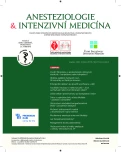Tracheal intubation in intensive care – a life saving or life threathening procedure?
Authors:
Černá-Pařízková Renata
Authors‘ workplace:
Klinika anesteziologie, resuscitace a intenzivní medicíny, Univerzita Karlova v Praze, Lékařská fakulta v Hradci Králové, Fakultní nemocnice Hradec Králové
Published in:
Anest. intenziv. Med., 24, 2013, č. 6, s. 391-395
Category:
Intensive Care Medicine - Review Article
Overview
Tracheal intubation (TI) is a routine procedure on the ICU. Complications related to TI are some of the most frequent and rather underrated problems in the critical care setting. Patients requiring TI on the ICU usually suffer from organ dysfunction of various severity and very often have poor organ reserves. The lack of time for adequate evaluation and pre-oxygenation of these patients often results in hypoxemia and subsequently a cardiac arrest. It is recommended to apply difficult airway algorithms used in operating theatres to the intensive care environment. Preparation of „bundles of tracheal intubation“ and its implementation to the clinical practice can be a useful strategy for airway management in intensive care.
Keywords:
tracheal intubation – intensive care
Sources
1. Griesdale, D. E., Bosma, T. L., Kurth, T., Isag, G., Chittock, D. R.Complications of endotracheal intubation in the critically ill. Intensive Care Med., 2008, 34, p. 1835–1842.
2. Jaber, S., Amraoui, J., Lefrant, J. Y. et al. Clinical practice and risk factors for immediate complications of endotracheal intuba-tion in the intensive care unit: A prospecive, multiple-center study. Crit. Care Med., 2006, 34, p. 2355–2361.
3. Divatia, J. V., Khan, P. U., Myatra, S. N. Tracheal intubation in the ICU: life saving or life threatening? Indian J. Anaesth., 2011, 55, s. 470–475.
4. Martin, L. H., Mhyre, J. M., Shanks, A. M., Tremper, K. K., Kheterpal, S. 3,423 emergency tracheal intubations at a university hospital: airway outcomes and complications. Anesthesiology, 2011, 114, p. 42–48.
5. Mort, T. C. Preoxygenation in critically ill patients requiring emergency tracheal intubation. Crit. Care Med., 2005, 33. p. 2672–2675.
6. Mort, T. C. Esophageal intubation with indirect clinical tests during emergency tracheal intubation: A report of patient morbidity. J. Clin. Anesth., 2005, 17, p. 255–262.
7. Mort, T. C. Emergency tracheal intubation: Complications associated with repeated laryngoscopic attempts. Anesth. Analg., 2004, 99, p. 607–613.
8. Cook, T. M., Woodall, N., Harper, J. and Benger, on behalf of the Fourth National Audit Project. Majos complications of airway management in the UK: results of the Fourth National Audit Project od the Royal College of Anaesthetists and the Difficult Airway Society. Part 2: intensive care and emergency departments. BJA, 2011, 106, 5, p. 632–642.
9. Woodall, N., Frerk, C., Cook, T. M. Can we make airway management (even) safer? – lessons from national audit. Anaesthesia, 2011, 66, Suppl 2, p. 27–33.
10. Wittekamp, B. H. et al. Clinical review: Post-extubation laryngeal edema and extubation failure in critically ill adult patients. Critical Care, 2009, 13, p. 233
11. Chan, Ch. M., Mitchell, A. L., Shorr, A. F. Etomidate is associated with mortality and adrenal insufficiency in sepsis. A meta-analysis. Crit. Care Med., 2012, 40, 11, p. 2945–2953.
12. Blanié, A., Ract, C., Leblanc, P. E. The limits of succinylcholine for critically ill patiens. Anesth. Analg., 2012, 115, p. 873–887.
13. Baillard, Ch. et al. Noninvasive ventilation improves preoxygenation before intubation ofhypxic patients. Am. J. Respir. Crit. Care Med., 2006, 174, p. 171–177.
14. Jaber, S., Jung, B., Corne, P., Sebbane, M., Muller, L., Chanques, G. et al. An intervention to decrease complications related to endotracheal intubation in the intensive care unit: A prospective, multiple-center study. Intensive Care Med., 2010, 36, p. 248–255.
15. Naguib, M., Flood, P., McArdle, J. J., Brenner, H. R. Advances in neurobiology of the neuromuscular junction: implications for the anesthesiologist. Anesthesiology, 2002, 96, 1, p. 202–231.
16. Hansen, D. Suxamethonium-induced cardiac arrest and death following 5 days of immobilization. Eur. J. Anaesthesiol., 1998, 15, p. 240–241.
17. Černý, V. Difficult Airway Society Guidelines for the management of tracheal extubation. Anest. intenziv. Med., 23, 2012, 5, p. 278–279.
18. Cook, T. M. et al. Major complications of airway management in the UK: results of the Fourth National Audit Project of the Royal College of Anaesthetists and the Difficult Airway Society. Part 1: Anaesthesia. Br. J. Anaesth., 2011, 106, 5, p. 632–642.
Labels
Anaesthesiology, Resuscitation and Inten Intensive Care MedicineArticle was published in
Anaesthesiology and Intensive Care Medicine

2013 Issue 6
Most read in this issue
- Tracheal intubation in intensive care – a life saving or life threathening procedure?
- Difficult airway management. Three happy ending case reports
- Emergence delirium after use of sevofluranein children
- Post-transplant right ventricular failure management
